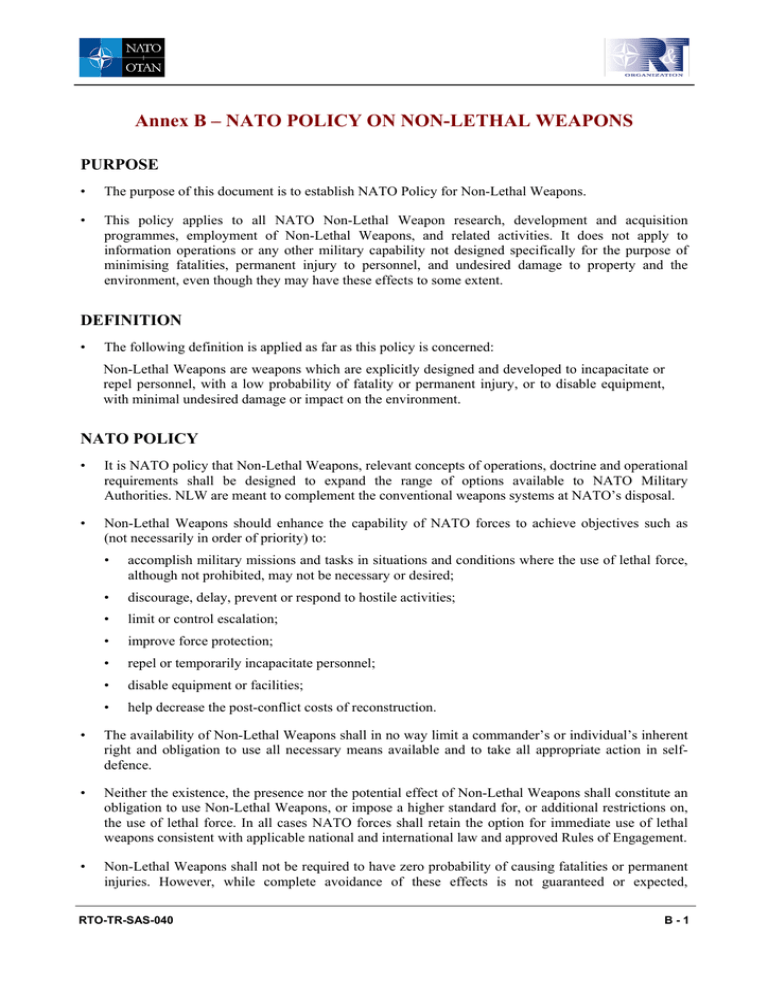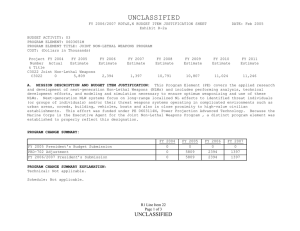Annex B – NATO POLICY ON NON-LETHAL WEAPONS PURPOSE
advertisement

Annex B – NATO POLICY ON NON-LETHAL WEAPONS PURPOSE • The purpose of this document is to establish NATO Policy for Non-Lethal Weapons. • This policy applies to all NATO Non-Lethal Weapon research, development and acquisition programmes, employment of Non-Lethal Weapons, and related activities. It does not apply to information operations or any other military capability not designed specifically for the purpose of minimising fatalities, permanent injury to personnel, and undesired damage to property and the environment, even though they may have these effects to some extent. DEFINITION • The following definition is applied as far as this policy is concerned: Non-Lethal Weapons are weapons which are explicitly designed and developed to incapacitate or repel personnel, with a low probability of fatality or permanent injury, or to disable equipment, with minimal undesired damage or impact on the environment. NATO POLICY • It is NATO policy that Non-Lethal Weapons, relevant concepts of operations, doctrine and operational requirements shall be designed to expand the range of options available to NATO Military Authorities. NLW are meant to complement the conventional weapons systems at NATO’s disposal. • Non-Lethal Weapons should enhance the capability of NATO forces to achieve objectives such as (not necessarily in order of priority) to: • accomplish military missions and tasks in situations and conditions where the use of lethal force, although not prohibited, may not be necessary or desired; • discourage, delay, prevent or respond to hostile activities; • limit or control escalation; • improve force protection; • repel or temporarily incapacitate personnel; • disable equipment or facilities; • help decrease the post-conflict costs of reconstruction. • The availability of Non-Lethal Weapons shall in no way limit a commander’s or individual’s inherent right and obligation to use all necessary means available and to take all appropriate action in selfdefence. • Neither the existence, the presence nor the potential effect of Non-Lethal Weapons shall constitute an obligation to use Non-Lethal Weapons, or impose a higher standard for, or additional restrictions on, the use of lethal force. In all cases NATO forces shall retain the option for immediate use of lethal weapons consistent with applicable national and international law and approved Rules of Engagement. • Non-Lethal Weapons shall not be required to have zero probability of causing fatalities or permanent injuries. However, while complete avoidance of these effects is not guaranteed or expected, RTO-TR-SAS-040 B-1 ANNEX B – NATO POLICY ON NON-LETHAL WEAPONS Non-Lethal Weapons should significantly reduce such effects when compared with the employment of conventional lethal weapons under the same circumstances. • Non-Lethal Weapons may be used in conjunction with lethal weapon systems to enhance the latter’s effectiveness and efficiency across the full spectrum of military operations. • NATO planners shall ensure that the potential contribution of Non-Lethal Weapons is taken fully into account in the development of their plans. • Non-Lethal Weapons shall conform to the definition contained in Section II above and have, as a minimum, the following characteristics: • They must achieve an appropriate balance between the competing goals of having a low probability of fatality or permanent injury, with minimal undesired damage, and a high probability of having the desired effects. • They must not be easily defeated or degraded by hostile countermeasures once known or, if they could be so defeated, the benefits of a single opportunity to use such a weapon in a given context would, nevertheless, be so great as to outweigh that disadvantage or any risk of consequent escalation. • The research and development, procurement and employment of Non-Lethal Weapons shall always remain consistent with applicable treaties, conventions and international law, particularly the Law of Armed Conflict as well as national law and approved Rules of Engagement. ADDITIONAL POLICY GUIDANCE • B-2 Any future request for additional policy guidance shall be referred to the North Atlantic Council. RTO-TR-SAS-040



